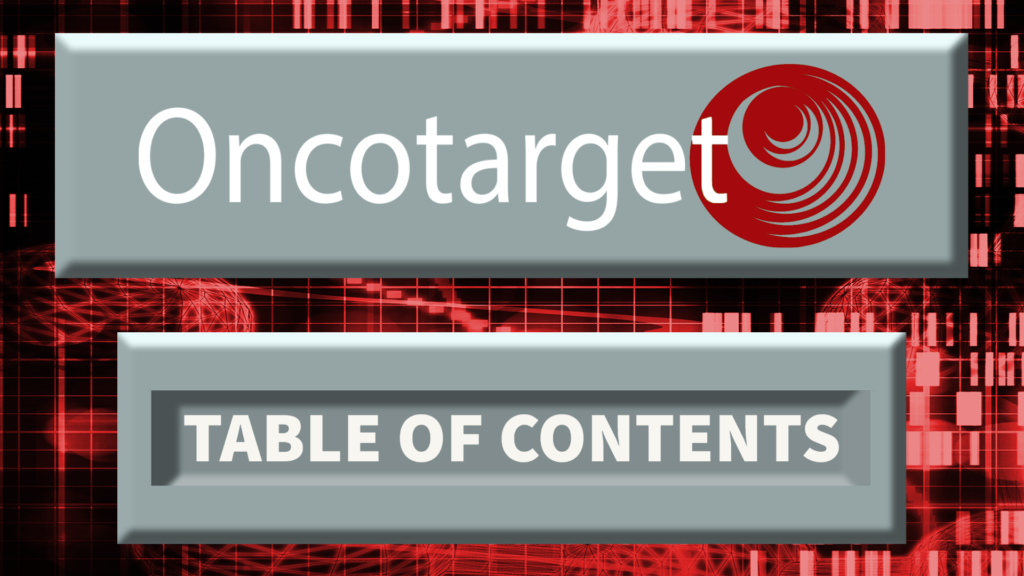Read short summaries of the latest oncology-focused research published in this week’s issue of Oncotarget, Volume 12, Issue 13.

Oncotarget’s Volume 12, Issue #13
New Publications
Cover (Research Paper): Oncogenic transformation of NIH/3T3 cells by the overexpression of L-type amino acid transporter 1, a promising anti-cancer target
Origin: Osaka, Miyagi, Chiba, Hyogo, Japan
Institutions: Kindai University, Tohoku University, Tokyo University of Science, Hyogo University of Health Sciences
Quote: “In this study, we thoroughly examined the oncogenicity of native and mutant human LAT1 in the NIH/3T3 system, followed by several biological analyses using NIH/3T3 cell lines expressing native or mutant LAT1, and found LAT1 to be a promising anti-cancer target.”
News: A new class of radiosensitizers for glioblastoma
Origin: Virginia, United States
Institution: University of Virginia
Quote: “News on: Creation of a new class of radiosensitizers for glioblastoma based on the mibefradil pharmacophore by Paradkar et al. Oncotarget. 2021; 12:891–906. https://doi.org/10.18632/oncotarget.27933. [PubMed]”
Research Paper: A platform for locoregional T-cell immunotherapy to control HNSCC recurrence following tumor resection
Origin: Jerusalem, Israel; Oregon, United States
Institutions: Hadassah and Hebrew University Medical Center, Providence Portland Medical Center, Oregon Health and Sciences University, The Oregon Clinic
Quote: “We hypothesized that local delivery of tumor antigen-specific T-cells into the resection cavity following surgery would direct T-cells to residual antigens in the margins and draining lymphatics and present a platform for T-cell-targeted immunotherapy.”
Research Paper: Human papilloma virus circulating tumor DNA assay predicts treatment response in recurrent/metastatic head and neck squamous cell carcinoma
Origin: Michigan, United States
Institution: University of Michigan
Quote: “Herein, we developed and analytically validated a new droplet digital PCR (ddPCR)-based assay for HPV16 circulating tumor DNA (ctDNA) and evaluated plasma HPV16 ctDNA for predicting treatment response in metastatic HPV+ OPSCC.”
Research Paper: Association of high-sensitivity C-reactive protein and odds of breast cancer by molecular subtype: analysis of the MEND study
Origin: North Carolina, Alabama, Kentucky, Kansas, United States; Lagos State, Osun State, Oyo State, Nigeria
Institutions: Duke University, University of Lagos, Obafemi Awolowo University Teaching Hospital, University of Ibadan, Federal Medical Center, UNC Gillings School of Global Public Health, Our Lady of Apostle Catholic Hospital, University of Alabama at Birmingham, University of Kentucky, University of Kansas Medical Center
Quote: “Breast cancer (BC) in Nigeria is characterized by disproportionately aggressive molecular subtypes. […] Ours is the first study, to our knowledge, to evaluate this relationship on the African continent, where TNBC prevalence is notably higher.”
Research Paper: Glucocorticoid receptor antagonism promotes apoptosis in solid tumor cells
Origin: California, United States
Institution: Corcept Therapeutics
Quote: “To guide studies in cancer patients, relacorilant, an investigational selective GR modulator (SGRM) that antagonizes cortisol activity, was assessed in various tumor types, with multiple cytotoxic combination partners, and in the presence of physiological cortisol concentrations.”
Research Paper: TERT and its binding protein: overexpression of GABPA/B in high grade gliomas
Origin: Cologne, Germany
Institution: University of Cologne
Quote: “In this study, we investigated the mRNA expression and association between TERT and GABPA/B isoforms in tumor samples of different glioma grades. The expression was determined by quantitative real-time PCR and the results were statistically analyzed.”
Review: Cross-talks in colon cancer between RAGE/AGEs axis and in-flammation/immunotherapy
Origin: Catanzaro, Italy
Institution: University Magna Græcia of Catanzaro
Quote: “In recent years, new mechanisms have been discovered and elucidated that link carcinogenesis with cellular metabolism in colon cancer. Despite these progresses, 25% of CRC patients are diagnosed at an advanced stage with a 5-year survival < 20%, and only limited targeted therapies are available [1].”
Review: Cancer-epigenetic function of the histone methyltransferase KMT2D and therapeutic opportunities for the treatment of KMT2D-deficient tumors
Origin: Texas, United States
Institution: The University of Texas MD Anderson Cancer Center
Quote: “In this review, we summarize recent advances in understanding the role of KMT2D in regulating tumorigenesis and discuss therapeutic opportunities for the treatment of KMT2D-deficient tumors.”
Research Perspective: Targeting super-enhancers reprograms glioblastoma central carbon metabolism
Origin: New York, United States; Ulm, Germany
Institutions: Columbia University Medical Center, Ulm University Medical Center
Quote: “Glioblastoma WHO IV (GBM) remains an incurable disease and an improved understanding of its metabolic properties may facilitate better treatments [1].”
Editorial Perspective: Polo-like kinase inhibition as a therapeutic target in acute myeloid leukemia
Origin: Connecticut, United States
Institution: Yale University
Quote: “The prognosis of patients with relapsed or refractory (R/R) acute myeloid leukemia (AML) is poor with median overall survival (OS) on the order of months especially in older and unfit patients [1, 2].”
Editorial: The formation of pre-effectors in the steady state opens a new perspective for cancer immunosurveillance
Origin: Missouri, United States
Institution: Saint Louis University School of Medicine
Quote: “Immunosurveillance refers to the identification and rejection of cancer cells by the immune system, and CD4+T cells play an important role in this process [1, 2].”
Editorial: Mechanisms of gefitinib-induced interstitial pneumonitis: why and how the TKI perturbs innate immune systems?
Origin: Miyagi, Japan
Institution: Tohoku University
Quote: “Gefitinib is a representative tyrosine kinase inhibitor (TKI) that blocks the tyrosine kinase activity of epidermal growth factor receptor (EGFR), and thereby exerts anticancer activity against various types of solid tumors, including inoperable non-small cell lung cancer with EGFR mutation [1].”
Click here to read Oncotarget’s Volume 12, Issue #13.
—
Oncotarget is a unique platform designed to house scientific studies in a journal format that is available for anyone to read—without a paywall making access more difficult. This means information that has the potential to benefit our societies from the inside out can be shared with friends, neighbors, colleagues, and other researchers, far and wide.
For media inquiries, please contact media@impactjournals.com.



